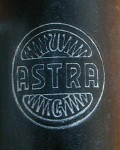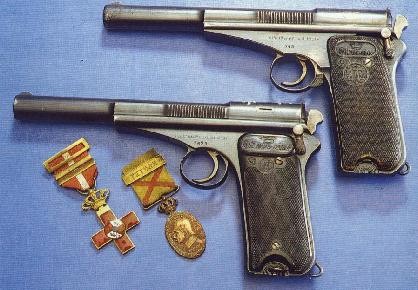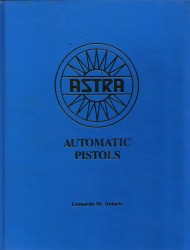CRUFFLER.COM
presents
HISTORIC
FIREARM OF THE MONTH,
November
1999:
 |
 |
 |
 |
 |

Image Credit: The Astra Homepage http://web.jet.es/apraiz/b_spsteel_astra.html |
Production
of the Campo-Giro continued until 1919, when the Spanish War Ministry decided
that the pistol should be replaced by a more contemporary design.
In 1920, Esperanza y Unceta was invited to participate in a competition
which would determine the next Spanish military issue pistol.
The tests included only three pistols: The Astra Model 400 prototype submitted by |
Spanish patent number 68209 of 1919 (modified in 1921) was issued to Pedro Careaga for the Model 400's design. The Model 400 was based on a direct blow back design, with no mechanical locking system to keep the breech closed. In order to handle the powerful catridge it was designed for, the 9mm Largo, a combination of a powerful recoil spring and a powerful mainspring (thus requiring more force to move the hammer to the cocked position) was used. The mainspring was located around the Model 400's 150mm barrel, giving the distinctive tubular shaped slide. Sights were a fixed front and a fixed integral rear. All standard Model 400 pistols were rust blued. The barrel, internal barrel bushing, trigger, hold open and thumb safety were highly polished and left in the white. Other parts, such as the extractor, grip screws, and magazine release were heat tempered to a fire blue. In the course of repair, parts that were originally fire blued were rust blued. Later reworks used a salt blueing process.
The Model 400, in both commercial and official incarnations, was numbered in a separate serial number range from other Esperanza y Unceta products, starting at number 1 and continuing through number 105,275. This might lead one to believe that there were only 105, 275 Model 400's produced. Not so! The Model 400's delivered to the Navy in 1924 duplicated the serial numbers in the Army range from 28,901 to 29,800, thus bringing the total number of Model 400's produced to 106,175. It is also noteworthy that the pistols delivered to the Spanish Navy incorporated a different magazine release that was later standardized in the Models 300 and 600. Specifically, the release was relocated from the rear bottom of the grip to the side.
Production of the Model 1921 continued through the Spanish Civil War, arming both sides. After the city of Guernica, where the Astra factory was located, was captured in 1937 by General Franco's nationalist forces, production continued for only the Franco regime. To overcome this shortcoming in sidearms, ersatz Model 400 production was set up in areas of Spain still controlled by the Republicans. Two main variants of the ersatz Model 400 were produced: Between 5,000 and 8,000 were manufactured by the Republican Arsenal in Tarrasa, and marked F. Acaso after Francisco Acaso, a Spanish anarchist linked to a number of political assassinations who died early in the Civil War and was treated as a Republican martyr. An additional 15,000 were produced by a private firm in Valencia, and maked RE, which stood for "Republica Espanola."
There were two major exports of the Model 400. In 1930, a group of 842 guns was sent to the Chilean Navy (serial numbers 36,359 through 37,200), and some 5,950 guns were sent to Nazi Germany in 1941 (serial numbers 92,851 - 98,800). While additional guns were exported to Colombia, Ecuador, and the United States, these were shipped via independent exporters, and their exact numbers are unknown.
In 1946, the Spanish military determined that it was time to retire the Model 400 in favor of a more modern design. The replacement for the Astra 400 was the Star Super A, a conventional locked breech Browning design. Starting in the 1960's, the American collector community was favored with the importation of surplus Astra 400's.
WARNING: It is often suggested that the Astra Model 400, due to its unique chamber, was designed to fire a wide variety of nominally 9mm diameter cartridges, ranging from the 9mm Parabellum to the 9mm Browning Long to the .38 ACP to the .38 Super to the 9mm Steyr. THIS IS UNTRUE. The ONLY cartridge that one should attempt to fire in an Astra 400 is the 9mm Largo. Failure to do so may result in a spontaneous disassembly of the firearm and severe injury or death to the shooter.
BIBLIOGRAPHY
Antaris, Leonardo M. , Astra Automatic Pistols, (FIRAC Publishing Company, Sterling, Colorado: 1988)
Astra
Automatic Pistols is available from IDSA Books. Click on the
image to order:

|
|